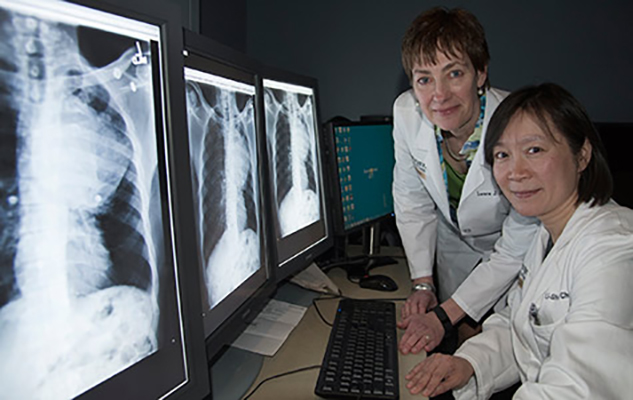
Smokers with a specific genetic variation are more likely to keep smoking longer than those who don’t have the gene variant, new research indicates. They’re also more likely to be diagnosed with lung cancer at a younger age.
Researchers at Washington University School of Medicine in St. Louis led an analysis of 24 studies involving more than 29,000 smokers of European ancestry and found that smokers with a particular variation in a nicotine receptor gene were more likely to continue smoking for four years after those without the variant had quit. Those with the genetic variant also were more likely to be diagnosed with lung cancer four years earlier than those without the variation in the CHRNA5 gene.
The findings may result in changes to efforts to screen patients for lung cancer. They are published April 14 in the Journal of the National Cancer Institute.
“People with the risk variant average a four-year delay in the age at which they quit smoking,” said first author Li-Shiun Chen, MD. “Instead of quitting at age 52, which was the average age when study participants with a normal gene stopped smoking, people with the genetic variant quit at age 56.”
Chen said those with the gene variant also tend to inhale more deeply when they smoke. That combination of genes and behavior contributes to the development of lung cancer earlier in life.
“They are likely to be diagnosed four years earlier,” she said. “In those with lung cancer, the average smoker without the gene variant is diagnosed at age 65. Those with the greater genetic risk tend to be diagnosed at 61.”
Chen said the presence of the gene variation has important clinical implications. Smokers who have the gene variant could undergo lung cancer screening at a younger age, she said. In addition, previous work from Chen and senior investigator Laura Jean Bierut, MD, shows that those with the gene variant are more likely to respond to medications that help people quit smoking, so knowing more about a smoker’s genetic makeup could help guide that individual’s therapy.
“The same people with this high-risk gene are more likely to respond to smoking-cessation medications, such as nicotine-replacement patches, lozenges or gum,” Chen said. “Although it’s clear the gene increases the chances a person will develop lung cancer at a younger age, it also is clear that the risk can be reversed with treatment.”
Lung cancer is the most common cancer worldwide, making up 13 percent of all cancer cases and leading to 27 percent of all cancer deaths. And survival rates are low. About half of all lung cancer patients die within a year of being diagnosed. Only about one in six are still alive five years after diagnosis.
“So a diagnosis that comes four years earlier is very significant clinically,” Chen explained.
Bierut, the Alumni Endowed Professor of Psychiatry at Washington University, said the clinical implications of the findings are enormous. Currently, people tend to be screened for lung cancer according to how much they smoke and how old they are. But the new research supports the idea of doctors using genetic information to target people who might not be screened otherwise, she explained.
“Adding this information to screening criteria could help us focus our resources on people at the highest risk,” Bierut said. “In addition, knowing that they are the ones most likely to respond to nicotine-replacement therapy could allow us to respond with treatments that are more likely to be effective.”
Chen and Bierut plan to expand their studies to include smokers from ethnic groups not represented in this analysis. They also want to look at other genes related to smoking, nicotine dependence and cancer risk, with the goal of creating a risk score that could be used to assess addiction and cancer risk in individual smokers.